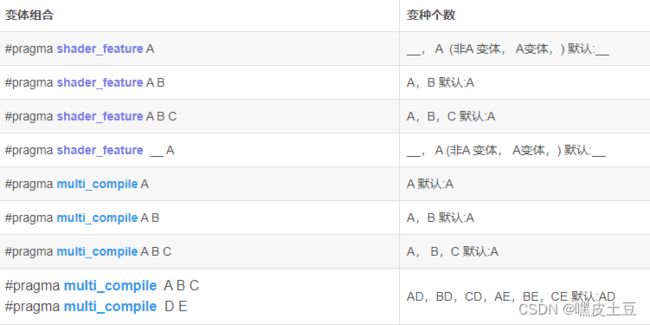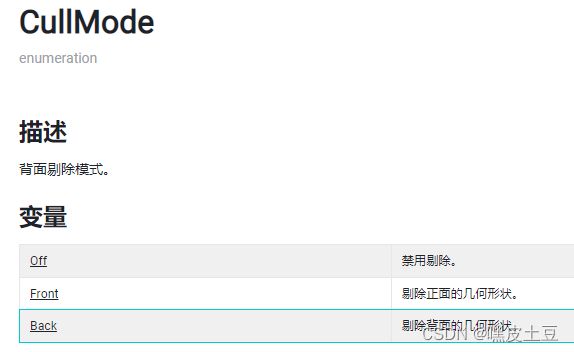Unity Shader 学习笔记(5)Shader变体、Shader属性定义技巧、自定义材质面板
写在之前
Shader变体、Shader属性定义技巧、自定义材质面板,这三个知识点任何一个单拿出来都是一套知识体系,不能一概而论,本文章目的在于将学习和实际工作中遇见的问题进行总结,类似于网络笔记之用,方便后续回顾查看,如有以偏概全、不祥不尽之处,还望海涵。
1、Shader变体
先看一段代码
......
Properties{
[KeywordEnum(on,off)] USL_USE_COL("Is Use Color Mix Tex?", int) = 0
[Toggle(IS_RED_ON)]_IsRed("IsRed?", int) = 0
}
......//中间省略,后续会有完整代码
#pragma multi_compile USL_USE_COL_ON USL_USE_COL_OFF
//"_" 代表除了ON之外的另外一种情况
#pragma multi_compile IS_RED_ON _
......
要点总结:
1.两种在属性菜单内定义 宏 (变体) 的方式;
2.“#pragma multi_compile” 作为定义变体的一种方式,对比的还有 “#pragma shader_feature”两种方式构建全局变体;
3.二者区别在于:
“#pragma multi_compile” 无差别构建Shader,即根据定义的变体数量,排列组合出全部的Shader可能,利用内存的空间,换取加载时间和速度;
此处引用站内的一位朋友的文章,并且借用他的一张图表示一下变体的排列组合方式和规则:在此表示感谢;

“#pragma shader_feature” 在打包之后,材质球用到的变体组合才会打包出来,没有用到的变体组合是不会打包的,但是缺点也是很明显,即导出之后如果想用没有导出的变体组合,是会报错的,相对于 “#pragma multi_compile” 只有内存开销会小一些。
Tips:顺便说一下分支语句:
最常见的分支语句:
a. 动态分支:
if(A){}//动态加载语句
else{}//优点:可以选择条件A进行判断,同时可以在一个 Shader 内实现动态加载,即时切换分支;
//缺点:由于动态加载,所以运算开销会多一些,因为需要全部分支内容走过一遍,才能判断最终需要走的分支,所以时间和开销比较浪费。
b. 静态分支:
此处引用一下本文分享的Shader代码:
......
#if defined (USL_USE_COL_ON)
#if defined (IS_RED_ON)
mainColor = fixed4(1,0,0,col.a);
col *= mainColor;
#else
mainColor = fixed4(0,1,0,col.a);
col *= mainColor;
#endif
#else
col = mainColor;
#endif
......
这里使用了静态分支的嵌套,静态分支的各种属性:
原理:着色器编译时选择代码分支;
使用条件:在编译之前就已经是确定的执行条件,编译之后只会运行已经确定的分支,同时编译器会裁剪没有激活的分支;
小注意:目前Unity的最新版本已经建议使用 “#if defined(A)” 这种方式,所以在选择时也不用过多纠结其余的写法,跟着官方走就好了。
c. 着色器变体
没错,着色器变体其实属于分支语句的一种,是更高级的静态分支;
着色器变体的原理:
编译时,生成多个静态分支的着色器版本;
运行时,根据要使用的Shader功能动态选择要执行的着色器版本;
解释一下这个原理,上面已经说过变体会排列组合的生成很多着色器版本,只是在运行时会选择性使用着色器版本;
所以从涵盖关系上看,每一个变体所排列组合出来的着色器版本,就是某些静态分支的组合;
从灵活度上看,静态分支更像是一个Shader的固定渲染方案,此时想要其他的渲染效果,总不至于重新写Shader,此时利用变体的组合,就可以在一个Shader内创造出另外一种渲染可能,相同的是,新创造出来的着色器版本也是静态分支渲染,只有一种渲染结果。
d.总结
可以这样说,着色器变体是静态分支更高级的用法,为本来需要写很多Shader的工作量集合到一个Shader内,让Unity自动生成着色器版本,自动选择要使用的版本。
而动态分支就是在一个Shader内分出多条不同的渲染路线,根据设置的条件选择最终的渲染方案,可以在编译之后的工作中仍可灵活选择一种方案。
2、Shader属性定义技巧
还是引用一段代码:
[Enum(UnityEngine.Rendering.CullMode)] _Culling("Cull Mode", int) = 2
[Enum(UnityEngine.Rendering.BlendMode)] _BleModSour("Blend-Source", int) = 5
[Enum(UnityEngine.Rendering.BlendMode)] _BleModDest("Blend-Destination", int) = 10
_MainColor("ColorTest", Color) = (1,1,1,1)
_MainTex ("Texture", 2D) = "white" {}
[KeywordEnum(on,off)] USL_USE_COL("Is Use Color Mix Tex?", int) = 0
//[Toggle]_IsRed("IsRed?", int) = 0
[Toggle(IS_RED_ON)]_IsRed("IsRed?", int) = 0
_StencilRef("Stencil Ref ID", int) = 0
[Enum(UnityEngine.Rendering.CompareFunction)] _StencilComp("Stencil Comp Style", int) = 3
a. Enum 类型
在 Shader 内可以引用Unity的部分API,其中 “UnityEngine.Rendering.CullMode” 就是其中的一种,类似的还有下面的几种引用可以参见Unity官方文档参考,这边不做过多解释。
着重说一下以下两行代码:
//关键词表示变体,在后续的变体引用中,需要将关键字配合“Enum”内的字体变成大写引用
//具体引用结果参见后文全部代码;
[KeywordEnum(on,off)] USL_USE_COL("Is Use Color Mix Tex?", int) = 0
[Toggle(IS_RED_ON)]_IsRed("IsRed?", int) = 0
//上述两行都是创建了变体,但是后者会更加简单一些,同时在Material UI上的显示方式
//也是略有差别,看情况选择性使用;
![]()
第一种方式是一个下拉选择菜单,同时支持多种结果选择;
第二种则是勾选框,只有 是否 两种选择。
b. 属性的引用方式
常见的
在属性内定义,然后在 Shader 的 CG/HLSL 片段内重新定义,然后就可以在后续的顶点片元着色器使用;
......
fixed4 _MainColor;
sampler2D _MainTex;
float4 _MainTex_ST;
//int _IsRed;
......
特别的
......
SubShader
{
Tags { "RenderType"="Transparent" "Queue" = "Transparent"}
LOD 100
//使用 [] 的方式替换特定的一种选择,这样就可以避免重定义再使用属性的问题,
//同时这样对于美术同学很是友好。
Blend [_BleModSour][_BleModDest]
Cull[_Culling]
Stencil
{
Ref [_StencilRef]
//Comp Equal
Comp [_StencilComp]
}
Pass
{......}
......
第二种引用方式需要在官方文档内注意引用的属性的顺序,例如:

引用时,默认值 “0” 对应 “Off”,默认值 “1” 对应 “Front”, 默认值 “2” 对应 “Back”,其他的引用属性一样类推。
3、自定义材质面板
在 Shader 内增加一行代码:(最后的位置)
......
return fixed4(col.rgb, col.a);
}
ENDCG
}
}
//就是下面这一行代码:
//需要注意这个名称对应脚本的名称,一定是对应上的。
CustomEditor "MainShaderGUI"
}
完整的脚本代码:
using UnityEngine;
using UnityEditor;
//名称和Shader内的名称一一对应,和脚本的文件名完全一致
public class MainShaderGUI : ShaderGUI
{
static bool TextureColor;
static bool CullAndBlendMode;
static bool StencilProperties;
//定义脚本内需要引用的 Shader 属性名称并赋值;
MaterialProperty _Culling = null;
MaterialProperty _BleModSour = null;
MaterialProperty _BleModDest = null;
MaterialProperty _MainColor = null;
MaterialProperty _MainTex = null;
MaterialProperty USL_USE_COL = null;
MaterialProperty _IsRed = null;
MaterialProperty _StencilRef = null;
MaterialProperty _StencilComp = null;
// #region 和 #endregion 二者一一对应;
//作用:
//1. 分段代码,方便后续的修改和更新,使代码结构清晰;
//2. 在Material 面板上,可以起到分割和避免重叠的作用;
public override void OnGUI(MaterialEditor materialEditor, MaterialProperty[] properties)
{
#region Shader Properties
//将Shader属性在脚本内一一对应
_Culling = ShaderGUI.FindProperty("_Culling", properties);
_BleModSour = ShaderGUI.FindProperty("_BleModSour", properties);
_BleModDest = ShaderGUI.FindProperty("_BleModDest", properties);
_MainColor = ShaderGUI.FindProperty("_MainColor", properties);
_MainTex = ShaderGUI.FindProperty("_MainTex", properties);
USL_USE_COL = ShaderGUI.FindProperty("USL_USE_COL", properties);
_IsRed = ShaderGUI.FindProperty("_IsRed", properties);
_StencilRef = ShaderGUI.FindProperty("_StencilRef", properties);
_StencilComp = ShaderGUI.FindProperty("_StencilComp", properties);
#endregion
#region Culling And Blend
//新建一个下拉菜单UI,返回一个 Bool 值;
//"Cull And Blend" 是这个下拉菜单的名称;
CullAndBlendMode = EditorGUILayout.Foldout(CullAndBlendMode, "Cull And Blend", true, EditorStyles.foldout);
if (CullAndBlendMode)//动态分支选择,相当于 if(true){}
{
GUILayout.Space(10);//空格(一行)
//下拉菜单内包含的属性;
materialEditor.ShaderProperty(_Culling, new GUIContent(_Culling.displayName));
materialEditor.ShaderProperty(_BleModSour, new GUIContent(_BleModSour.displayName));
materialEditor.ShaderProperty(_BleModDest, new GUIContent(_BleModDest.displayName));
GUILayout.Space(10);
}
#endregion
#region Color And Tex
Rect r_texturecolor = EditorGUILayout.BeginVertical("Button");//增加背景方便分类识别
TextureColor = EditorGUILayout.Foldout(TextureColor, "Color And Texture", true, EditorStyles.foldout);
if (TextureColor)
{
GUILayout.Space(10);
materialEditor.ShaderProperty(_MainColor, new GUIContent(_MainColor.displayName));
materialEditor.ShaderProperty(_MainTex, new GUIContent(_MainTex.displayName));
materialEditor.ShaderProperty(USL_USE_COL, new GUIContent(USL_USE_COL.displayName));
materialEditor.ShaderProperty(_IsRed, new GUIContent(_IsRed.displayName));
GUILayout.Space(10);
}
EditorGUILayout.EndVertical();//增加背景的结束语句;
#endregion
#region Stencil Properties
StencilProperties = EditorGUILayout.Foldout(StencilProperties, "Stencil Properties", true, EditorStyles.foldout);
if (StencilProperties)
{
GUILayout.Space(10);
materialEditor.ShaderProperty(_StencilRef, new GUIContent(_StencilRef.displayName));
materialEditor.ShaderProperty(_StencilComp, new GUIContent(_StencilComp.displayName));
GUILayout.Space(10);
}
#endregion
}
}
材质面板对比:(脚本使用之前和之后)
面板折叠收起:
中间的折叠面板是为了跟好的区分不同属性块。
4、完整Shader代码:
Shader "USL/Shader Advanced Writing"
{
Properties
{
[Enum(UnityEngine.Rendering.CullMode)] _Culling("Cull Mode", int) = 2
[Enum(UnityEngine.Rendering.BlendMode)] _BleModSour("Blend-Source", int) = 5
[Enum(UnityEngine.Rendering.BlendMode)] _BleModDest("Blend-Destination", int) = 10
_MainColor("ColorTest", Color) = (1,1,1,1)
_MainTex ("Texture", 2D) = "white" {}
[KeywordEnum(on,off)] USL_USE_COL("Is Use Color Mix Tex?", int) = 0
//[Toggle]_IsRed("IsRed?", int) = 0
[Toggle(IS_RED_ON)]_IsRed("IsRed?", int) = 0
_StencilRef("Stencil Ref ID", int) = 0
[Enum(UnityEngine.Rendering.CompareFunction)] _StencilComp("Stencil Comp Style", int) = 3
}
SubShader
{
//Tags { "RenderType"="Opaque" }
Tags { "RenderType"="Transparent" "Queue" = "Transparent"}
LOD 100
Blend [_BleModSour][_BleModDest]
Cull[_Culling]
Stencil
{
Ref [_StencilRef]
//Comp Equal
Comp [_StencilComp]
}
Pass
{
CGPROGRAM
#pragma vertex vert
#pragma fragment frag
// make fog work
#pragma multi_compile_fog
#pragma multi_compile USL_USE_COL_ON USL_USE_COL_OFF
//"_" 代表除了ON之外的另外一种情况
#pragma multi_compile IS_RED_ON _
//此双变体形式组合成四种Shader :
//两两组合,默认不规定 #if 的情况下使用变体的第一种组合,USL_USE_COL_ON + IS_RED_ON
#include "UnityCG.cginc"
struct appdata
{
float4 vertex : POSITION;
float2 uv : TEXCOORD0;
};
struct v2f
{
float2 uv : TEXCOORD0;
UNITY_FOG_COORDS(1)
float4 vertex : SV_POSITION;
};
fixed4 _MainColor;
sampler2D _MainTex;
float4 _MainTex_ST;
//int _IsRed;
v2f vert (appdata v)
{
v2f o;
o.vertex = UnityObjectToClipPos(v.vertex);
o.uv = TRANSFORM_TEX(v.uv, _MainTex);
UNITY_TRANSFER_FOG(o,o.vertex);
return o;
}
/*
//变体和动态选择(if + else)可以组合使用。
fixed4 frag (v2f i) : SV_Target
{
// sample the texture
fixed4 col = tex2D(_MainTex, i.uv);
fixed4 mainColor = _MainColor;
// apply fog
UNITY_APPLY_FOG(i.fogCoord, col);
#if defined (USL_USE_COL_ON)
if (_IsRed)
{
mainColor = fixed4(1,0,0,1);
col *= mainColor;
}
else if(!_IsRed)
{
mainColor = fixed4(0,1,0,1);
col *= mainColor;
}
col *= mainColor;
#else
col = mainColor;
#endif
return col;
}
*/
fixed4 frag (v2f i) : SV_Target
{
// sample the texture
fixed4 col = tex2D(_MainTex, i.uv);
fixed4 mainColor = _MainColor;
// apply fog
UNITY_APPLY_FOG(i.fogCoord, col);
//变体嵌套的形式结果
#if defined (USL_USE_COL_ON)
#if defined (IS_RED_ON)
mainColor = fixed4(1,0,0,col.a);
col *= mainColor;
#else
mainColor = fixed4(0,1,0,col.a);
col *= mainColor;
#endif
#else
col = mainColor;
#endif
return fixed4(col.rgb, col.a);
}
ENDCG
}
}
CustomEditor "MainShaderGUI"
}
写在最后:
能看到最后的,估计寥寥无几,如果觉得写的还可以,可以点个赞,让我知道还是有人需要这种比较初级的教程,本文只能简单的陈述一下,并不能完整的将项目经验进行传达,有必要的情况还请留言。
如果有写的不好的地方,还请大佬批评指正,感谢。

